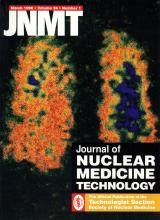Abstract
Objective: In pediatric nuclear medicine efforts to reduce the distress of the child is essential. Sedation is indicated when other means are not sufficient. The choice of sedative and the route of administration are important issues. Midazolam administered intranasally has proven to be safe and efficient. In this study we have compared midazolam given as nasal drops with midazolam given as nasal spray.
Methods: Of 376 children (age 0.5–15 yr), 233 received midazolam as nasal drops (0.3 mg/kg body weight) and 143 as nasal spray (0.2 mg/kg body weight) prior to venipuncture or during gamma camera examinations. The conditions for the procedures were judged on a four-level arbitrary scale.
Results: Mean time to adequate sedation was 7 min in both groups. Conditions during procedures were significantly better after spray administration. Good or acceptable cooperation was recorded in 77.3% for nasal drops compared to 86.7% for nasal spray. Nasal discomfort was frequent, 28% and 39%, respectively, for drops and spray. Other side effects were rare and not significantly different between the two groups.
Conclusion: This study shows that nasal administration of midazolam is an excellent alternative for sedation in pediatric nuclear medicine and that nasal spray is favorable to nasal drops.







